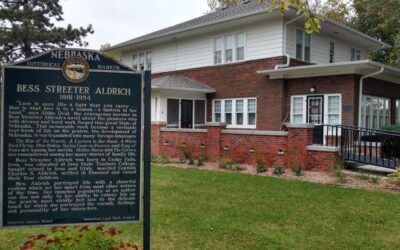 Precisely at 10 a.m. on June 20, 1952, a stylishly dressed middle-aged black woman named Mildred Brown urged the Omaha City Council to “do all in their power to see that Negroes were hired as bus drivers and therefore end the lily-white hiring practices of the Omaha & Council Bluffs Streetcar Company.” Speaking slowly, enunciating each word and standing at her tallest, five feet, five inches, the publisher of the Omaha Star newspaper and representative of the De Porres Club directed her comments to the council chairman: “I say to you, your honor, the mayor, if the tram company will not hire Negroes as drivers we prevail on you to remove the franchise of the bus company.” Straightening the corsage fastened to her fuchsia-colored suit jacket, she abruptly turned on her matching colored high heels. Approaching her chair, Brown looked over her shoulder at the row of white men in ties, and said, “If our boys can drive jeeps, tanks and jet planes in Korea in the fight to save democracy, make democracy work at home.
Precisely at 10 a.m. on June 20, 1952, a stylishly dressed middle-aged black woman named Mildred Brown urged the Omaha City Council to “do all in their power to see that Negroes were hired as bus drivers and therefore end the lily-white hiring practices of the Omaha & Council Bluffs Streetcar Company.” Speaking slowly, enunciating each word and standing at her tallest, five feet, five inches, the publisher of the Omaha Star newspaper and representative of the De Porres Club directed her comments to the council chairman: “I say to you, your honor, the mayor, if the tram company will not hire Negroes as drivers we prevail on you to remove the franchise of the bus company.” Straightening the corsage fastened to her fuchsia-colored suit jacket, she abruptly turned on her matching colored high heels. Approaching her chair, Brown looked over her shoulder at the row of white men in ties, and said, “If our boys can drive jeeps, tanks and jet planes in Korea in the fight to save democracy, make democracy work at home.
Born in Alabama in 1905, Mildred Brown was the owner, publisher, and editor of the Omaha Star, which she co-founded in 1938. An iconoclastic leader, Brown nurtured, encouraged, and spoke for her black readership until her death in 1989. But the years of her most intense civil rights activity coincide with the existence of the De Porres Club, a pioneering civil rights organization in Omaha that was active between 1947 and 1960. Brown “was one of those individuals who became involved in the civil rights struggle long before it was fashionable.”
As one of the nation’s few black newspaper women and the only black woman to publish a newspaper in Nebraska, Brown occupied a unique and historic position. During the 1940s and 1950s, she and other De Porres Club members successfully created equal employment opportunities through boycotts and through the auspices of the Star. Brown’s weekly not only provided a voice for Near North Side residents but also provided the necessary communication for collective neighborhood activism. For her, it was more than a moral campaign; she felt it was her civic responsibility as a middle-class businesswoman living in the black community.
In February 1947, the Omaha Star printed a request for a community meeting. Brown wanted Near North Side residents to meet her downtown at the Young Women’s Christian Association (YWCA) building. She chose the location not only because she was a member of the YWCA, but also because of the organization’s interracial goals of anti-lynching laws, race relations, and female empowerment. Brown wished “to acquaint the people of the community with the facts of the lack of employment in the business places of this community.” She wanted “freedom from fear, want, and the right to equal opportunity.”
At the meeting, an interracial group of approximately thirty-five people listened to Brown expound on the unfairness of white business owners accepting the black community as customers but refusing them as employees. Brown’s staffers researched 534 available occupations listed in the 1940 census. They discovered that Omaha’s “Negroes have no employment in as many as 96 occupations.” Skilled black men and women applied for these positions, but their applications were rejected. Approximately a thousand black Near North Side citizens seeking work remained unemployed, while the few who found employment were “working for a livelihood at jobs far below their status, both in rank and pay.”
Brown told her audience they “must approach industry, commerce and big business with our problem and seek the opportunity to work and grow.” She demanded that those present act quickly: “Let us resolve to be a people, and subsequently act in a way to show we appreciate employment of members of our group by patronizing all business where there can be found Negroes working.” The interracial assembly agreed to convene again and elected Brown as their chairperson.
This is an excerpt from “Mildred Brown and the De Porres Club: Collective Activism in Omaha, Nebraska’s, Near North Side, 1947-1960” by Amy Helene Forss, which appeared in the Fall/Winter 2010 issue of Nebraska History.



